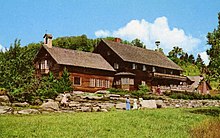
The Sound of Music is a musical with music by Richard Rodgers, lyrics by Oscar Hammerstein II, and a book by Howard Lindsay and Russel Crouse. It is based on the 1949 memoir of Maria von Trapp, The Story of the Trapp Family Singers. Set in Austria on the eve of the Anschluss in 1938, the musical tells the story of Maria, who takes a job as governess to a large family while she decides whether to become a nun. She falls in love with the children, and eventually their widowed father, Captain von Trapp. He is ordered to accept a commission in the German navy, but he opposes the Nazis. He and Maria decide on a plan to flee Austria with the children. Many songs from the musical have become standards, including "Do-Re-Mi", "My Favorite Things", "Edelweiss", "Climb Ev'ry Mountain", and the title song "The Sound of Music".

Georg Ludwig Ritter von Trapp was an officer in the Austro-Hungarian Navy who became the patriarch of the Trapp Family Singers.

Maria Augusta von Trapp DHS, often styled as “Baroness”, was the stepmother and matriarch of the Trapp Family Singers. She wrote The Story of the Trapp Family Singers, which was published in 1949 and was the inspiration for the 1956 West German film The Trapp Family, which in turn inspired the 1959 Broadway musical The Sound of Music and its 1965 film version.
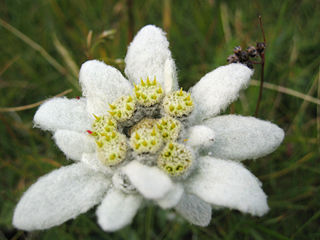
"Edelweiss" is a show tune from the 1959 Rodgers and Hammerstein musical The Sound of Music. It is named after the edelweiss, a white flower found high in the Alps. The song was created for the 1959 Broadway production of The Sound of Music, as a song for the character Captain Georg von Trapp. In the musical, Captain von Trapp and his family sing this song during the concert near the end of Act II. It is a statement of Austrian patriotism in the face of the pressure put upon him to join the navy of Nazi Germany following the Anschluss. It is also Captain von Trapp's subliminal goodbye to his beloved homeland, using the flower as a symbol of his loyalty to Austria. In the 1965 film adaptation, the song is also sung by the Captain earlier in the film when he rediscovers music with his children.
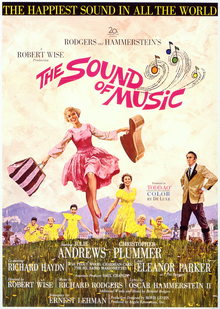
The Sound of Music is a 1965 American musical drama film produced and directed by Robert Wise from a screenplay written by Ernest Lehman, and starring Julie Andrews and Christopher Plummer, with Richard Haydn, Peggy Wood, Charmian Carr, and Eleanor Parker. The film is an adaptation of the 1959 stage musical composed by Richard Rodgers, with lyrics by Oscar Hammerstein II and a book by Lindsay and Crouse. It is based on the 1949 memoir The Story of the Trapp Family Singers by Maria von Trapp and is set in Salzburg, Austria. It is a fictional retelling of her experiences as governess to seven children, her eventual marriage with their father Captain Georg von Trapp, and their escape during the Anschluss in 1938.
Trapp is a surname. Notable people with the surname include:

The Story of the Trapp Family Singers is a 1949 memoir written by Maria Augusta von Trapp, whose life was later fictionalized in Rodgers and Hammerstein's Broadway musical The Sound of Music in 1959.
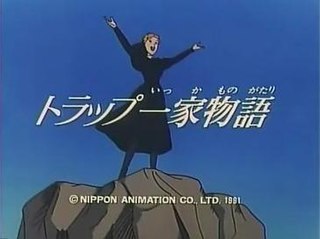
Trapp Family Story is a 1991 Japanese animated series by Nippon Animation, based on the story of the real-life Austrian singing family the Trapp Family. It is a part of the World Masterpiece Theatre franchise, which adapted classic works of literature into animated TV shows. 40 episodes aired on Fuji TV.
Elisabeth von Trapp is an American folk singer.

Agathe Johanna Erwina Gobertina von Trapp was the eldest daughter of Georg von Trapp and his first wife, Agathe Whitehead von Trapp. She was also a member of the Trapp Family Singers, whose lives were the inspiration for the 1959 musical play and 1965 film The Sound of Music. She was portrayed as the character "Liesl".

Maria Agatha Franziska Gobertina von Trapp was the second-oldest daughter of Georg von Trapp and his first wife, Agathe Whitehead von Trapp. She was a member of the Trapp Family Singers, whose lives inspired the musical and film The Sound of Music. She was portrayed by Heather Menzies as the character "Louisa". She died at age 99, and was the last surviving sibling portrayed in the film.
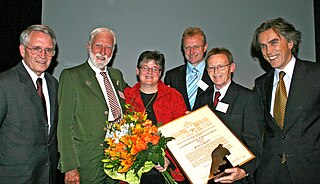
Trapp Family Austrian Relief, Inc. is an initiative founded by Georg von Trapp and Maria von Trapp of the famous Austrian singing family, the Trapp Family, and which was an integral part of the effort to promote the Austria victim theory.
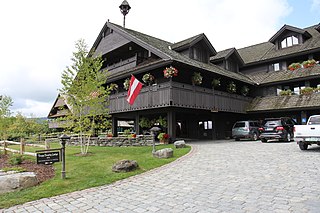
The Trapp Family Lodge is a 2,500-acre (10 km2) resort located in Stowe, Vermont. It is managed by Sam von Trapp, son of Johannes von Trapp of the Austrian musical family, the Trapps. It was formerly known as Cor Unum.
The Von Trapps was a musical group made up of Sofia, Melanie, Amanda, and August von Trapp, descendants of the original Trapp Family Singers. They are the grandchildren of Werner von Trapp, who was portrayed as Kurt in The Sound of Music, and the great-grandchildren of Georg Ritter von Trapp and his first wife Agathe Whitehead, and the step-great-grandchildren of Maria von Trapp, Georg's second wife.
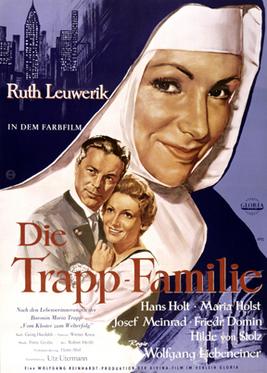
The Trapp Family is a 1956 West German comedy drama film about the real-life Austrian musical family of that name directed by Wolfgang Liebeneiner and starring Ruth Leuwerik, Hans Holt, and Maria Holst. Based on Maria von Trapp's 1949 memoir, The Story of the Trapp Family Singers, the film is about a novice nun sent to care for the unruly children of a wealthy baron, who falls in love with and marries the young woman. Through her caring influence, the family becomes a famous singing group. When the baron is pressured to join Hitler's navy, the family escapes to the United States, where they establish themselves as singers.
Johannes von Trapp is an American Austrian singer and former member of the Trapp Family Singers, whose lives were the inspiration for the musical and movie The Sound of Music. He is the tenth and youngest child. As of September 2023, Johannes is the last surviving sibling of the von Trapp family.

The Trapp Family in America is a 1958 West German comedy drama film about the real-life Austrian musical Trapp Family directed by Wolfgang Liebeneiner and starring Ruth Leuwerik, Hans Holt, and Josef Meinrad. It is a sequel to the 1956 film The Trapp Family. It was shot at the Bavaria Studios in Munich. The film's sets were designed by the art director Robert Herlth.

The von Trapp Family: A Life of Music is a 2015 German-Austrian musical drama film based on the lives of the Austrian singing Trapp Family directed by Ben Verbong and starring Rosemary Harris, Matthew Macfadyen, Eliza Bennett, Lauryn Canny, and Yvonne Catterfeld. It is an English-language adaptation of Agathe von Trapp's 2003 book Agathe von Trapp: Memories Before and After The Sound of Music.

Agathe Gobertina von Trapp was a British-Austrian heiress and aristocrat. She was the first wife of Georg Ritter von Trapp and the mother of seven children of the Trapp Family singers.
Rosmarie Agathe Erentrudis von Trapp was an American singer, teacher, and missionary. She was the first daughter of Maria von Trapp and Georg von Trapp.




